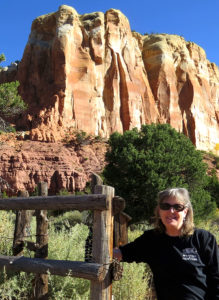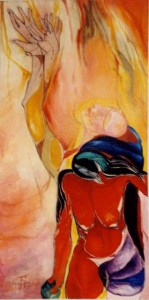Dear Artist,
For those who might wonder why music plays such a great role in human life and culture, Daniel J. Levitin has written This is Your Brain on Music. The book contains remarkable insights and new information on music, song and dance. Some researchers think music may actually predate speech. Others see it as a wayward deviation that only ends in harmless play. Curiously open-ended and open-minded, there’s something on every page of Levitin’s book that has me asking similar questions about the brain and painting.
Folks have been making marks on cave walls for almost as long as they’ve been humming and whistling. And folks have been painting some sort of pictures, getting attention and impressing others for longer than rockers have been rocking for chicks. Can these arts be related to the business of attracting a mate — or are they some form of mass or private beguilement? Further, has evolution hard-wired some of us to our brushes? If so, what’s the nature of this wiring, why do we plug into it, and what’s it good for?
Among many other enrichments, three words keep reappearing in Levitin’s book — rhythm, repetition and novelty. Here’s how I feel they might just apply to our game:
Rhythm is an elemental force in human nature. In visual art, the moving brush and the wandering eye are directed toward harmonious cycles and shapes that amuse and satisfy. This rhythm is between curves and flats, protrusions and recessions, crudeness and delicacy, patterns and amorphousness, lines and forms. As in music, the list goes on.
Repetition is one of those strangely satisfying curiosities that somehow helps us feel rewarded and secure. Repeated motifs, themes and stylistic peculiarities give a “beat” to visual art that seduces the eye and brings it back for more. Far from being boring, repetition is the grid on which higher themes may fly.
At the same time, the human brain and eye love novelty. Something new around the corner — a surprise, a jolt out of the normal — arrests our flow and gives a sudden flush of wonder and joy. In the evenness that describes so much of life, humanity craves the bump of novelty.
Best regards,
Robert
PS: “Another possibility is that evolution selected creativity in general as a marker of sexual fitness.” (Daniel J. Levitin)
Esoterica: Coincidentally, on recent jury duty I was paying attention to the choices of my fellow jurors. For the most part they chose art that was not necessarily technically competent or perfectly rendered. What held the juror’s attention and received the highest number of votes was work that appeared to me to overflow with rhythm, repetition and novelty. Coincidentally, I had just watched the works being painted on location, and those winning artists also seemed hard-wired to having the most fun.
This letter was originally published as “This is your brain on painting” on August 14, 2009.
The Letters: Vol. 1 and 2, narrated by Dave Genn, are now available for download on Amazon, here. Proceeds of sales contribute to the production of The Painter’s Keys.
“I believe that the great painters, with their intellect as master, have attempted to force the unwilling medium of paint and canvas into a record of their emotions. I find any digression from this large aim leads me to boredom.” (Edward Hopper)
Featured Workshop
 Ghost Ranch, New Mexico, Darla Bostick, (June and October) workshops
Ghost Ranch, New Mexico, Darla Bostick, (June and October) workshops
Relax, enjoy, create!
Photography/watercolors/acrylics/mixed media. Group activity room (floor to ceiling vista). Ghost Ranch Lodging/meals provided. See why Georgia O’Keeffe loved Ghost Ranch. Each workshop/retreat is different. The June workshop leans heavier on all kinds of materials –textiles and dye, printing, painting, pouring and more! The October workshop combines the media of photography, watercolor, ink, acrylic and more — using watercolor paper, clayboard, etc!
Daily demos, slide presentations, door prizes and optional happy hour. The website shows how I work from Ghost Ranch scenes to finished paintings. www.darlabostick.com
Featured Artist
Monique Jarry is a Canadian and a graduate of the Ecole des Beaux-Arts de Montreal.









12 Comments
Agree with having fun. When an artist feels like they are put in a vice grip it’s time to step back.
re: PS: “Coincidentally, on recent jury duty I was paying attention to the choices of my fellow jurors. For the most part they chose art that was not necessarily technically competent or perfectly rendered. What held the juror’s attention and received the highest number of votes was work that appeared to me to overflow with rhythm, repetition and novelty. Coincidentally, I had just watched the works being painted on location, and those winning artists also seemed hard-wired to having the most fun.”
I am glad to read about those artistic souls who in the role of juror is willing and able to think outside the box.
This way of painting is how I have been from the very beginning. I tried to be more realistic and the reference to the vice is so true. I finally just surrendered to my authentic self and I am much more comfortable. I have buckets of fun. My work is to my surprise ,very well received. That’s just how I’m “wired”. I really enjoyed this piece.
Reflection!
Art is the mirror of the soul
“Rocking for chicks” ??? Really?!?!
“Rocking for chicks” ? Really?!?!
You might like to know a recently open cave with prehistoric painting also yielded a primitive “flute”. Music and painting developed together.
Check out ‘wingmakers.com’ — Ancient Arrows Project. It is utterly fascinating! Cave paintings and music possibly from the stars.
Unbelievably, no one sees the musician or the painter as a co “creator”. We’re wired that way because we’re made in His image. Nature is full of rhythm, repetition and novelty, We’re just tapping into The Source.
Our jury system is one case/one day so if you don”t get selected on the day you are summoned to report, you are released. I have been called for duty (hee hee!) five times and every single time all potential jurors were sent home because the trials on the docket that day got settled or postponed. My husband, on the other hand, has been called 4 times and put on a jury 4 times! I think the process of being a juror would be fascinating in the abstract but faced with the reality of deciding someone”s fate would be very tough for me. I”m a true Libra who can see both sides of almost any argument. I”m pretty sure I”d cause a hung jury. best custom essay
My guess is that dance preceded both music and painting. Dance is movement purely for the sake of moving and we have observed primates and other animals moving, it seems, just as an expression of the joy and exhilaration of life. Rhythm followed and then chanting, music and finally language. Cave painting was somewhere in that mix. The trance aspects are important in much of the primal painting. Rhythm is one way of inducing trances, so possibly cave painting came along with the introduction of rhythm. In all of this, one thing seems clear, art was one of the most important elements in the development and survival of our species.
If evolution selected creativity as a marker for “sexual fitness,” I wonder why so many composers and artists were homosexual.